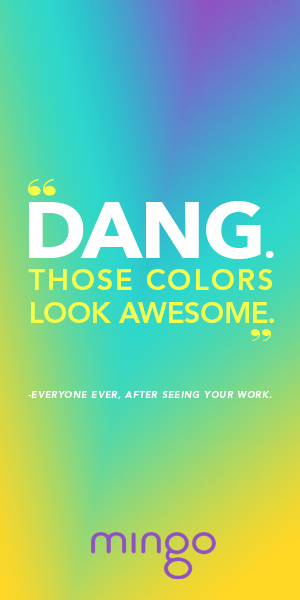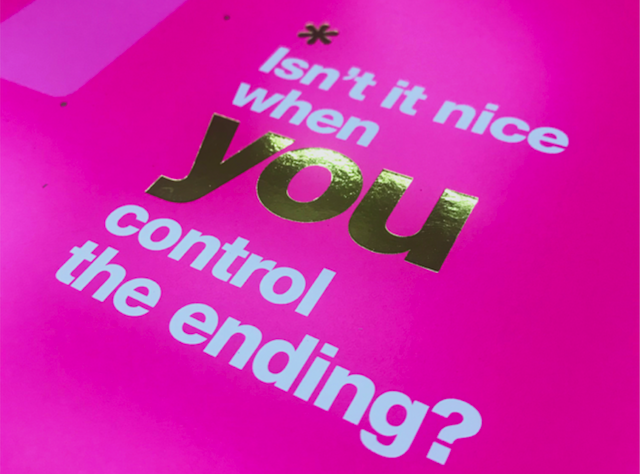Ever wondered what it takes to pique a customer’s interest? Here’s the thing: consumers crave stories, and the recent rise of “narrative branding” proves as much. But just like with any great drama or epic adventure, if you want people to stick around, you have to give them a reason to do so.
From direct mail to social media, everything we design, write, print, or promise at Mingo Press starts with our brand story. By using splashy, design-driven imagery and user-friendly language that sounds like it was plucked right out of out the office Slack channel (imagine a wink and a nod with a dash of sass), we’re able to keep our message simple and our story clear: Mingo is a designer’s best friend.
A great story is the difference between a company, corporation, or side hustle, and a bonafide brand — especially when you’ve got the right audience in mind. The next time you set out to talk to them, keep these nine tips in mind.
1. Know where the story’s headed.
Rule #1 of story-based branding: know where you’re headed. That could be sale, a newsletter sign-up, or a share — whatever you understand your objective to be. At Mingo, a big part of our brand story is personal service, so our story arc usually leads to a good ol’ fashioned phone call.
When you call Mingo, you get a real, live human being every time (no robots here, thankyouverymuch). It’s a critical piece of our brand story as stewards of your creativity. We want our customers to call us up whenever they have a job because as a brand, we value the certainty that comes with dealing with real people.
2. Build character motivation around customer satisfaction.
When we first started shaping our brand story, we paid special attention to our customers’ pain points. By asking them about the things that drive them crazy, we learned that a world without rush fees, a website that translates the ins and outs of printing into digital specs, file-friendliness across the board, and talking to a real, live human being were all major selling points for our clientele. Today, these values show up everywhere on Mingo’s site.
Developing a sense of motivation for our customers helped us better understand the things that make them tick, and be a better partner to them overall. It’s made all the difference, and makes Mingo’s story one of creativity and camaraderie.
3. Let characterization drive your story.
Here’s a tip: the easier you make it for everyone to understand your story and characters, the faster they’ll buy into them. Take Mingo’s customer service department, Team Picasso, for example. Team Picasso’s sole purpose is to help customers express their creativity effectively, on time, and within budget. The team’s role is super clear: be a customer champion. And we’re not shy about that either; it’s all over our website, front and center in our brand voice, and proven by the way we build customer relationships.
After developing the characterization of Team Picasso, we noticed that our customers started using the team more often. Plus, there’s more narrative cohesion in our brand story now, and that is a beautiful thing.
4. Make sure you choose the right channel.
Selling printing digitally demands that we translate an offline artform into online storytelling. Especially at a time when so much of the world’s communication happens digitally, and print is becoming rarer and more specialized, the fact that a piece is printed at all is a narrative in and of itself.
With this in mind, we decided the best place for us to tell our story was through channels that let our customers touch and feel the finished product. Every year, we concept a new direct mail campaign that gets our capabilities into the right people’s hands, and use our website, email, and social media accounts to tell complementary stories and pique interest along the way.
5. Don’t forget about the illustration.
A good brand story looks as great as it sounds, so don’t forget to add some color to your correspondence. That could mean anything from an identity mark that alludes to your core product offering to a color palette that capitalizes on a certain emotion.
For Mingo, that means creating a brand story that comes to life through paper, color, coatings, die-cuts, lithography, and finishes. Our story is all about helping our consumers tell their own, so we pay extra attention to how our specialties can shape and enhance their vision and narrative. Dynamic die-cuts, special embossing, and finishes that make our personality pop solidifies our characterization as a designer’s best friend, and a steward of creativity.
6. Throw in some plot twists.
It’s a simple fact that consumers like to be surprised. Mounds of data have proven as much, as have the lines that organically form around the free sample tables at the grocery store. When done the right way, consumers love to be delighted with unexpected moments of joy. In fact, we believe this so wholeheartedly in the power of a plot-twist that we designed our entire 2016 marketing campaign around the idea.In The Happiness Campaign, we built a narrative around the belief that happiness is having something to look forward to. We let the element of surprise drive our printing, our design choices, and our story arc by sending small, unexpected treats to customers throughout the year. By using plot twists to keep fans on their toes, we saw a major increase in advertising engagement for the year, and a pretty sizeable bump in product sales, too.
7. Establish your own Point of View.
Truth be told, while it’s super important to understand how customers view your brand, it’s equally important to flesh out the story of why you exist to serve them in the first place. What’s your stance on service? How does your brand play in the world at large? How do your offerings speak to your greater mission? At the end of the day, these are the narrative choices that drive customer loyalty.At Mingo, we do our best to stay laser-focused in our perspective of the world: what good work looks like, why the world needs creativity, and how we can best shepherd that along from our own small corner of the universe. We aren’t saving lives, but we are making them a lot more beautiful, and we see a lot of value in that work.
8. Make it true for every audience.
A good brand narrative is built to be true for every reader, and brings in your secondary audience (your team!), as well. In thinking about your story, ask yourself: does it account for all my characters? Mingo’s 2017 marketing campaign, The Story of Creative Thinkers, is told from the various points of view needed to bring a customer’s idea to life: designers, copywriters, illustrators, project managers, marketers, clients, and even Mingo. From conception to execution to distribution, each player in that story is critical to taking the printed piece (and the creative vision behind it) from idea to reality.
When it comes to building a brand story, make sure everyone on your team understands the message, and knows how to frame it for the next person in line. After all, there’s no point in building a brand story if your own team can’t buy into it.
9. Keep an eye on the point.
Your brand promise should be the light at the end of the tunnel, the undercurrent to your narrative, and the moral of the story. It’s the best message you have — don’t miss an opportunity to tell your fans why you exist!



